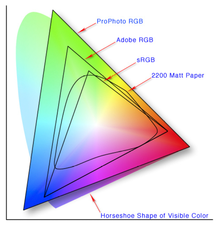Re: [ SPAM ] Re: Printer Qs
Posted by James Steiner on Nov 03, 2014; 4:04pm
URL: http://friam.383.s1.nabble.com/Printer-Qs-tp7585775p7585777.html

============================================================
FRIAM Applied Complexity Group listserv
Meets Fridays 9a-11:30 at cafe at St. John's College
to unsubscribe http://redfish.com/mailman/listinfo/friam_redfish.com
URL: http://friam.383.s1.nabble.com/Printer-Qs-tp7585775p7585777.html
As said, screens combine different intensities of three colors of light, typically red, green, and blue (RGB), to simulate color (our eyes conveniently blend the colors for us). This is called "additive" mixing, because we are adding light--the more we add, the closer to white we get. This is what we see on screens, whether CRT, LED, LCD, or giant color "game-tron" screens at stadiums made of arrays of light bulbs.
But on paper we can combine different densities of pigments (like printer ink, paints, and crayons), typically cyan, magenta, and yellow, and black (CMYK), to simulate color (likewise, our eyes and brains do the heavy lifting of blending the colors for us). This is called "subtractive" mixing, because we are removing light, in a way. The more of the colors we add, the closer we get to black.
So, color printers *can* also get nearly all possible colors, but by mixing cyan, magenta, and yellow and black (plus the white background), rather than red, green, and blue.
It's actually possible, to choose *any* three starting colors and mix them to get a number of other colors--but the colors are limited to those that fall within the triangle of hues defied by those three colors. This is called the "color space" made available by these three colors.
So, interestingly, RGB and CMYK can both produce many, many colors, but, there are, in fact, an infinity of conceivable, visible colors that exist in reality that *cannot* be accurately produced on any computer screen or CMYK printing process. They are colors that lie outside the color triangle produced by those specific hues of red, green, and blue or cyan, magenta and yellow.
However, printers (I mean, people who print things professionaly) can use single specific colors of pigment, too, just like painters (or even mixtures of those colors), to get colors outside the limits of the color space triangle.
Sources/References:

On Sun, Nov 2, 2014 at 10:25 PM, Russell Standish <[hidden email]> wrote:
On Sun, Nov 02, 2014 at 07:47:42PM -0700, Gillian Densmore wrote:
> Anyone care to speculate why printers don't use Red Green Blue +
> Saturation, I ask as you can make most any concievable color this
> way.
>
You just need to ask an artist who uses real paints this. Basically,
pigments work by absorbing certain frequencies. If you absorb red, the
resulting pigment looks like cyan, if you absorb green, you get
magenta and if you absorb blue you get yellow. By mixing these three
pigments on the page in different amounts, you can absorb differing
amounts of the RGB components of the incident light.
Printers will usually also add a black pigment, because if you add
equal parts of cyan, magenta and yellow, the result looks like a murky
brown, rather than the crisp black that you'd like.
Also note that children tend to learn these "secondary" colour
combinations, such as yellow+blue (really cyan) makes green, and so
on, because they're exposed to it through paints.
The next generation, brought up on iPads, may well learn the
primary combinations eg "red+green = yellow".
Cheers
--
----------------------------------------------------------------------------
Prof Russell Standish Phone 0425 253119 (mobile)
Principal, High Performance Coders
Visiting Professor of Mathematics [hidden email]
University of New South Wales http://www.hpcoders.com.au
Latest project: The Amoeba's Secret
(http://www.hpcoders.com.au/AmoebasSecret.html)
----------------------------------------------------------------------------
============================================================
FRIAM Applied Complexity Group listserv
Meets Fridays 9a-11:30 at cafe at St. John's College
to unsubscribe http://redfish.com/mailman/listinfo/friam_redfish.com
============================================================
FRIAM Applied Complexity Group listserv
Meets Fridays 9a-11:30 at cafe at St. John's College
to unsubscribe http://redfish.com/mailman/listinfo/friam_redfish.com
| Free forum by Nabble | Edit this page |